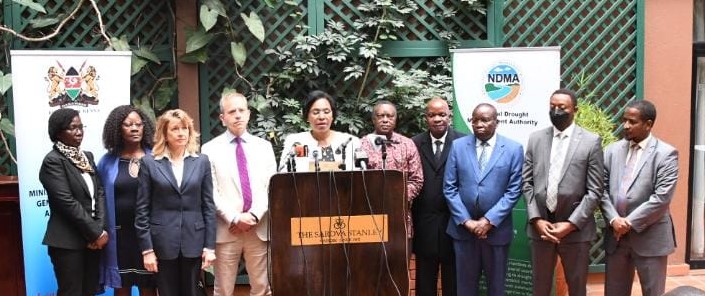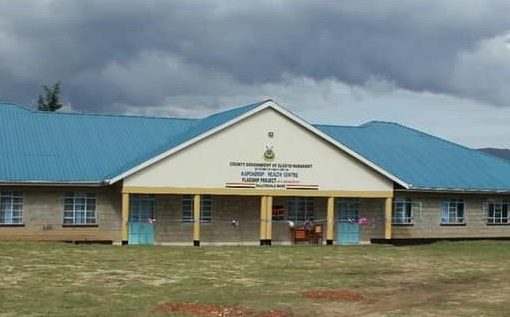The national government has spent more than Sh12.6 billion to cushion lives and livelihoods of vulnerable communities against the effects of the ongoing drought.
Ministry of Public Service, Gender, Senior Citizens Affairs and Special Programmes Cabinet Secretary (CS) Prof. Margaret Kobia said that currently, the number of people facing acute food insecurity are 3.5 million and the number is expected to rise to 4.1 million if the rains continue to fail.
Prof. Kobia speaking in Nairobi on Wednesday after a consultative meeting with donor agencies and other partners said that based on the Food Insecurity Phase Classification, three counties are in the emergency category, eight counties are in crisis, 12 counties are stressed and 24 counties are yet to be assessed.
“The government of Kenya has scaled up its drought mitigation efforts and to date has spent approximately Shs.12.6 billion on interventions which have been achieved through the support and collaboration with development partners, humanitarian agencies, the private sector and other non-state actors,” said CS Kobia.
Some of the interventions by the government has been Sh3.45 billion for cash transfers and relief food distribution during the 2021/22 financial year. This includes Sh1.95 billion spent on relief food distribution to 1.2 million people and Sh1.5 billion disbursed as Emergency Relief Cash Transfers.
Another Sh4.1 billion has been disbursed as cash transfers under the Hunger Safety Net Programme. This includes Sh3.2 billion regular cash payments to 96,689 households in Marsabit, Mandera, Wajir and Turkana and Sh861.4 million as drought shock-responsive scale-ups to 275,571 households.
The livestock commercial and slaughter offtake programme has used up Sh950 million while Sh446 million has been used for water response interventions and another Sh3.2 billion has been disbursed to 402,098 beneficiaries under the Inua Jamii social protection programmes.
Other interventions include Sh2.2 billion disbursed for the school feeding programme and procurement of canned beef for schools, targeting 851,987 learners in 2, 855 schools and Sh950 million and Sh446 million for livestock offtake (commercial and slaughter) and water response respectively.
The county governments have spent approximately Sh650 million while other partners and the private sector have used close to Sh1 billion on various drought response interventions.
Prof. Kobia said that despite the interventions, the persistent drought has left the country with a resource gap of more than Sh15 billion for interventions required in critical sectors of food security, health and nutrition, water, agriculture, livestock and education.
“The weather outlook indicates that there will be generally depressed rainfall across all the Arid and Semi-Arid counties during the October-December 2022 rainfall season due to La Nina hence the prospect of a 5th failed rain season,” she said.
The CS highlighted that consequently, the number of people in need of relief assistance could, therefore, rise to 4.4 million by December 2022.
“As part of this continuing support, we have also today launched Lisha Jamii an initiative established by the World Food Programme (WFP) that will provide food assistance to 535,000 (89,000 families) across 12 counties that are facing acute food insecurity,” said the CS.
She explained that the targeted counties are Turkana, Samburu, Isiolo, Garissa, Tana River, Baringo, Mandera, Wajir, Kitui, Kilifi, Kwale and Marsabit adding the food assistance will be provided for six months through both cash transfers and in-kind with beneficiary families set to receive Sh6,500 per month.
United Nations (UN) Resident Coordinator (Kenya) Stephen Jackson said that since President Uhuru Kenyatta announced the national drought emergency in September 2021, the government at national and county levels have been stepping up massively same as international partners.
“What is clear is that however fast we are running this crisis is running faster and out running us. Last year we were talking about 2.1 million people faced by severe food insecurity in Kenya but now we are looking at a prospect of more than double that number that is 4.4 million Kenyans going hungry if the fifth rains fail,” said Jackson.
He added that the situation would have been worse if the government and other stakeholders had not taken any measures to cushion the vulnerable.
“With the help of partners, we will be able to reach over 500,000 people nearly 100,000 families with cash assistance over the next six months but this is not enough since the crisis is outpacing us,” he said.
Jackson warned that if the rains fail in October 2022 then there will be a worse drought than anybody can remember in their lifetime.
By Joseph Ng’ang’a





